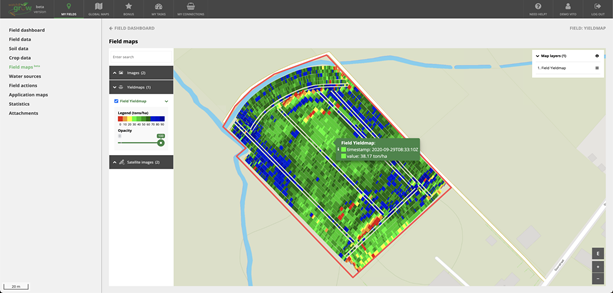
Potato farmer Jacob van den Borne participates in the pilot on “Open Platform for Improved Crop Monitoring in Potato Farms”. He is a pioneer in precision farming. Jacob collects a lot of data from his fields and uses the data to optimize field activities. He uses various platforms to visualize and analyze the data, including the WatchITgrow platform. As part of DEMETER he is now testing the automatic transfer of yield data collected with his AVR Puma 4.0 harvester to WatchITgrow.
Jacob, can you present yourself?
I’m Jacob van den Borne. I have a family farm in the south of the Netherlands, on the border with Belgium. I mainly grow potatoes, for fries, around 600 hectares.
What technology are you using?
On our farm we use all technologies that are available: soil scanning, crop sensing, satellite and drone imaging. We have connected machinery such as fertilizers, planters, sprayers, harvesters with yield mapping functionalities.
What are the challenges, the problems you are facing when using the technologies?
The biggest issue in using the technologies is to know how to operate the technology. Technically, all the machines are there and the technology is available but how to use it and how to make sense out of the data, that is the biggest hurdle these days. If we want to solve this, we need to teach farmers how to use the equipment but also why they should use it.
From a technical perspective, standardization is still an issue. If you use machines from different brands you will see that they all have their own way of logging and storing data, encrypted or not encrypted. The use of open standards would be a pro, but we see good progress there from ISOBUS, for example.
Other big issues are data cleaning and data tagging. Today it is not possible to add info about the quality of the data and that is really needed if you want to do good data analysis.
Connectivity is becoming less of an issue. In the past, machinery data were transferred using disks, USB sticks, but now we see a trend of doing everything online, in the cloud. Data transfer must be fully automatic. It should be easy, otherwise farmers will not collect data and they will certainly not use the data.
How do you use the technologies and what are the benefits you have found so far?

WatchItGrow Platform
By collecting a lot of data as we do, we try to get an idea of the yield potential of the fields, to be able to steer the inputs. Therefore we are looking at data from different sources, also data from past seasons. If we know we can achieve high yields on a particular field, we can invest more in that field. Or the other way around: if we can detect low yielding fields or low yielding zones within a field, find out the cause why these spots are not producing well and if we can then solve the problem, then we are making money. It can also happen that something is seriously wrong with the soil at those spots. In such cases it doesn’t make any sense to give more fertilizers but then we also know that we don’t have to invest further in those spots. Many farmers are today still focusing on improving the bad spots but sometimes that’s not possible. It’s better to focus on the good spots and try to get the most out of those. That’s my advice.


